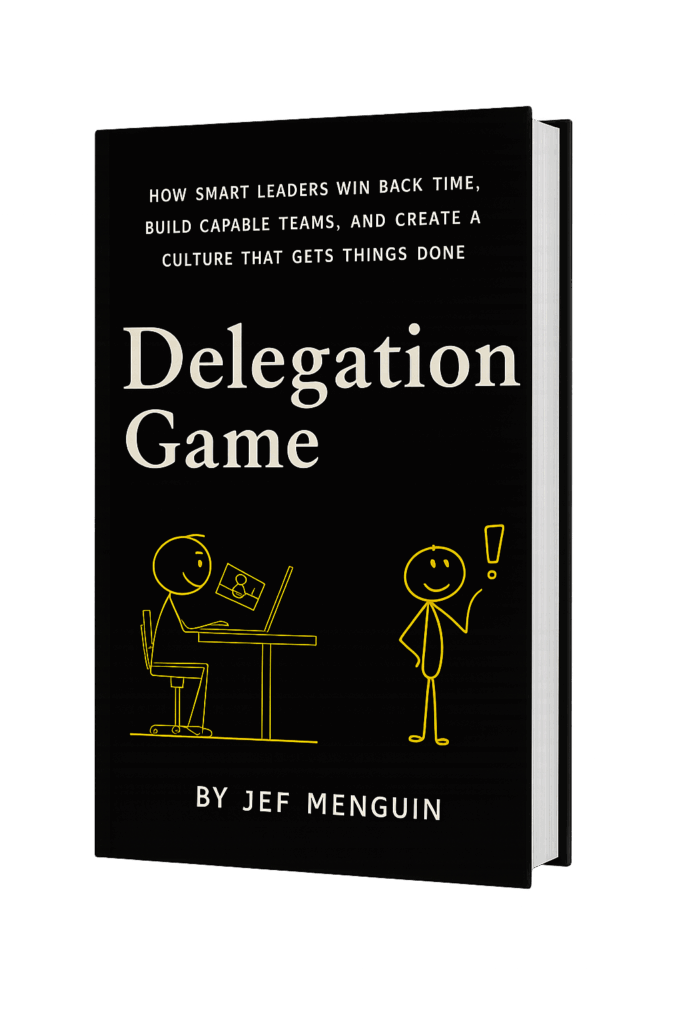You’ve probably done it: delegated a task with enthusiasm, told someone “This is yours”, and stepped back.
A week later, what comes back makes your stomach drop.
- The design went way off-brand.
- The budget ballooned.
- The client was promised something you can’t deliver.
What went wrong? You gave freedom without rules.
Delegation without boundaries isn’t empowerment—it’s chaos.
Why Boundaries Matter
In The Delegation Game, I wrote:
“Freedom without shape is confusion. Boundaries don’t box people in. They give form to freedom.”
That’s the secret. Boundaries aren’t about control. They’re about clarity. They tell your team:
- What’s off-limits so they don’t waste time or damage trust.
- What must be avoided so they don’t make unfixable mistakes.
- When to stop and check so they don’t go too far without alignment.
With these in place, people can move fast and think creatively—without fear of stepping on a landmine.
The Story of a Costly Oversight
Let’s talk about Raymond. He asked his marketing officer to run an ad campaign. Excited, the officer poured in time and energy.
The result? Beautiful ads, great reach—and a shocking bill. She had doubled the planned ad spend without realizing the budget cap.
Raymond was furious. She felt crushed. And the CFO demanded answers.
The mistake wasn’t her energy or effort. It was Raymond’s lack of boundaries. He never said, “This campaign can’t exceed ₱50,000 without approval.”
Boundaries would have prevented the blow-up.
Another Story: When Boundaries Built Confidence
Contrast that with Liza. She asked her senior analyst to evaluate vendors for a software upgrade. But before sending her off, she set three boundaries:
- Only consider vendors already on the approved list.
- Don’t negotiate final terms without her sign-off.
- Stop and check if any option exceeded the ₱500,000 ceiling.
With those in place, the analyst ran independently, interviewed vendors, and delivered a shortlist with clear recommendations. Liza didn’t have to hover. Her analyst didn’t have to second-guess.
That’s the difference: boundaries build confidence for both sides.
The Three Boundary Questions
Whenever you delegate, answer these three questions up front:
- What’s off-limits?
- Example: “Don’t contact the client directly until we agree.”
- Example: “Stick to the approved vendor list.”
- What must be avoided?
- Example: “Don’t promise delivery timelines without consulting operations.”
- Example: “Don’t exceed the design specs—we must match the brand book.”
- When should they stop and check with you?
- Example: “If costs go above ₱100,000, stop and check.”
- Example: “If the client requests a new feature, bring it back to me.”
These aren’t roadblocks. They’re guardrails. They prevent a crash while letting the car move at full speed.
Why Boundaries Aren’t Micromanagement
Micromanagement tells people how to do every little thing. Boundaries tell them the shape of success and the lines they shouldn’t cross.
Think of a basketball court. The lines don’t tell players how to dribble or shoot. They just mark what’s in play and what’s out. Within those lines, the game is free, fast, and creative.
Delegation works the same way. Boundaries create the court. Your team plays the game.
The Stakes of Skipping Boundaries
Without boundaries, here’s what you risk:
- Wasted effort: People do work that gets thrown out.
- Broken trust: Clients get promises you can’t keep.
- Costly mistakes: Budgets, compliance, or brand rules get ignored.
- Fearful teams: After one bad experience, people hesitate to take initiative again.
Boundaries don’t slow you down. They prevent disaster.
Answer These Questions
Before you hand off the next task, pause. Answer the three boundary questions in one or two sentences. Share them clearly.
Then step back. Watch your people move faster because they know where not to step.
As The Delegation Game reminds us:
“Boundaries aren’t fences. They’re the rules that let people play the game without breaking it.”
Your Move
Here’s your challenge this week:
- Pick one task you’re about to delegate.
- Write down the three boundary questions.
- What’s off-limits?
- What must be avoided?
- When should they stop and check?
- Share it with your delegate. Ask them to repeat it back in their own words.
Notice how much lighter you feel knowing the guardrails are in place.
Where We Go Next
This was Step 3 of the 7-Step Delegation Play. Coming next:
- Step 4: Give Authority & Resources – Opening Doors for Success.
- Step 5: Agree on Check-Ins – Oversight Without Hovering.
- Step 6 & 7: Document and Debrief – Learning and Upgrading Delegation.
With clear results (Step 1), the right match (Step 2), and firm but freeing boundaries (Step 3), you’re halfway to delegation that sticks.
